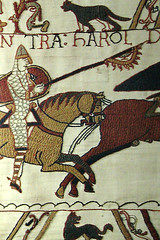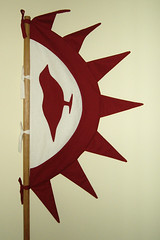Difficulty: Medium
Total Time: 7 hours
History
The Raven Banner is described in several literary accounts mention several battles including the battle at Cynuit in 878 CE. One account attributed the Raven Banner of Ubbe and a Danish army, which was defeated by King Alfred.
The Raven Banner is supposed to provide prophesy for the outcome of a battle. Some mention a banner with no embroidered image at all, whence a raven will magically appear upon it, beating its wings in victory or drooping its whole body in defeat.
The banner is mentioned again, and perhaps most famously, as a sigil of the Orkney Earls in connection with the Battle of Clontarf (1014 CE) and the battle at Dublin on Palm Sunday. The two saga’s describing these events – Orkneyinga Saga and Njal’s Saga describe the banner’s infamous curse, death to any standard bearer. “Now, take this banner. I've made it for you with all the skill I have, and my belief is this: that it will bring victory to the man it's carried before, but death to the one who carries it.”

Documentation
The Anlaf Sihtricsson coin minted at York in 924 may depict the Raven Banner. While it cannot be confirmed, the banner shows a triangular design with rectangular tassels hanging from the lower edge. In the scene of the Bayeux Tapestry where the brothers of Harold Godwinsson are slain a similar banner is depicted falling under the hooves of a horse. Unfortunately no design is shown on the flag to confirm the presence of a raven on the coin.
The Bayeux Tapestry depicts a second banner as the Normans ride into battle with a clear representation of a bird on a semi-circular banner, which may be the famous Raven. There are as many similarities as there are differences between this second banner and the coin.
Some scholars question why the Bayeux Tapestry should depict a Raven Banner in the hands of a Norman warrior. Two suggested answers include reference to an unrecorded Viking leader among William’s troops, or possibly an oblique reference to the Normans’ origin as Vikings under Hrolf der Ganger.
Construction
I created my pattern first out of newspaper working the white semi-circle to the maximum size the paper would allow and aiming for the rough proportions shown in the Bayeux Tapestry.
I cut the red border and the bird shape – two of each piece, one for each side - and also two white semi circles from linen material.
After sewing on the border to each white semi circle, I cut slits all the way around the inside seam, about an inch apart and just into the stitching. This allows the curve to sit better, which I ironed into place.
I pinned the bird shape, making sure that the bird was facing the top of each side in order to get "mirror images". Then I stitched it on, carefully rolling the edges in as I went to prevent fraying.
After stitching both of the birds on I created a pattern for each of my triangular flags. After three size checks I discovered that 20cm long and about 10cm wide worked the best. I allowed a seam edge and cut out 9 pairs, which I stitched together then turned and pressed with the iron.
After laying out my triangles with the semi-circular banner I found that I only needed 7, which I pinned on the inside and aligned the second semicircle. All of these layers were sewn together. Then I sewed down just the white area on the flat side.
NOTE: When you sew on the triangles remember that you want to sew right sides together, which means that your triangles end up inside the flag. When it is turned they will be on the right side.
I carefully turned the whole lot inside out through one of the small holes left in the red, then sewed up the holes.
The ties are made of 2cm wide tubes – I cut 6cm wide strips about 60-70cm long and turned them inside out after sewing, pressing them flat with the iron. Then I folded them in half and sewed them onto the banner at even intervals. After trimming and finishing off the ends by hand they are each about 20cm in length.
They are tied to the spear pole with a half bow which seems to hold them quite well and allows them to be removed and fixed to any other size poles if need be.
Additional Resources
The Vikings – Osprey Elite Series
The Bayeux Tapestry - David M Wilson
Viking Answer Lady - The Raven Banner




